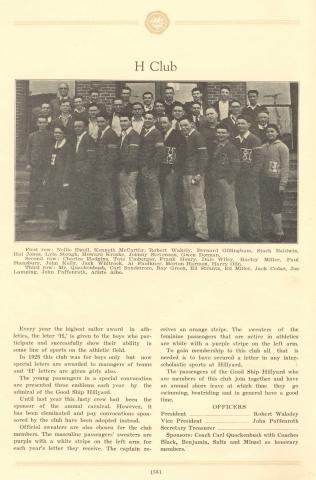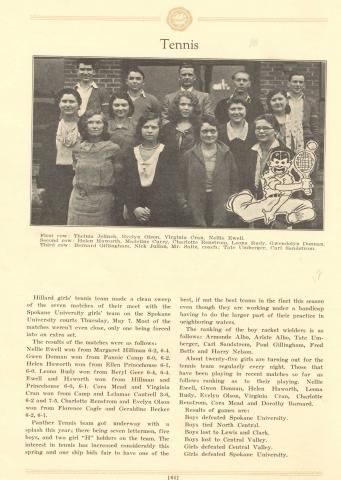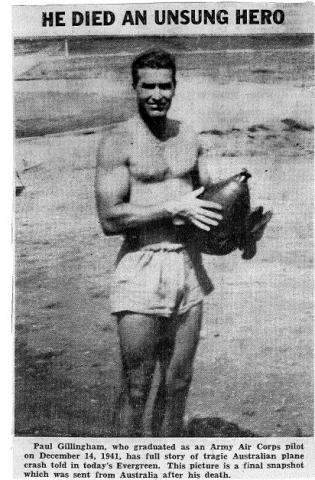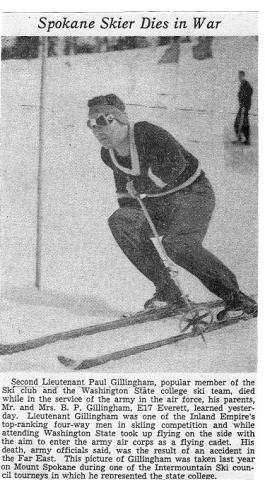Bernard Paul Gillingham
Pre-WSC Background
Bernard Paul Gillingham was born on May 19, 1914, to Benton Paul Gillingham and Olla Sensley Gillingham. He was the second of two sons; his older brother, Benton, was two at the time of his birth. Gillingham’s father worked as a blacksmith in Spokane, while Ola worked as a “saleslady” once her sons were in their teens. The elder Gillingham later operated a service station on North Division in Spokane.
Gillingham attended Hillyard High School in Spokane, later named John R Rogers High School beginning in 1932. He was well-known as an accomplished athlete. He played tennis, and during the 1930 season, he was the only Hillyard player to win a match against the West Valley team, defeating his opponent 6-4, 4-6, 6-4. He also won his doubles match, 6-4, 0-6, 6-3. He also belonged to the Art Club and served as the second-semester president of the club in 1932. Gillingham belonged to the “H” club, which became the “R” club once the school changed to Rogers High School. This group included “boys and girls who have won their monograms by competing in athletics,” and they adopted an official sweater that was purple with a white stripe on the left arm for each year’s service and an “orange stripe for the captaincy.”
Gillingham also was a boxer, and at a father-and-son mixer at Rogers High School in March 1932 gave a “clever example of bag punching.” Outside of school, Gillingham remained active. He made the Spokane Chronicle on December 8, 1931, because his boots were stolen while he was skating at Franklin Park. Gillingham graduated from Rogers with a specialty in Manual Arts in January 1933.
Gillingham made a name for himself as a skier after high school as a member of the Spokane Ski Club. In 1937 he was ranked “C” in downhill and slalom by the Pacific Northwest Ski Association. He was an accomplished bag punching artist and traveled for a period with a circus performing his act. Gillingham also worked in a bank in Spokane before attending Washington State College (WSC).
WSC Experience
Gillingham attended WSC from 1937 to 1941 as a Forestry major. While at WSC, he was a member of Phi Delta Theta, a fraternity founded in 1848 at Miami University. Phi Delta Theta believed in three pillars: the cultivation of friendship among its members, the acquirement individually of a high degree of mental culture, and the attainment personally of a high standard of morality, or friendship, sound learning, and rectitude. He also performed his bag punching routine for students’ entertainment, where he would “make that bag rattle until it sound like a machine gun and could keep it thumping in time to music by striking it with his elbows, chine, forehead or back of his head.” However, it was the sport of skiing for which Gillingham was known for during his time at WSC.
Gillingham’s involvement with skiing began with his tenure as president of the WSC Ski Club beginning during the 1937 to 1938 academic year. Skiing as a college sport was relatively new in the Pacific Northwest in the 1930’s, and Gillingham helped make a mark as a member of the varsity WSC ski team by competing in some of the earliest meets held regionally. In February 1938, he competed in the “first competition of its kind” at a triangular ski meet between the University of Idaho, Whitman College, and WSC. The event was sponsored by WSC at their student-owned winter sports area in the Moscow mountains. The meet served as tryouts for the big Northwest Intercollegiate ski meet held on the property of the Spokane Ski Club on Mount Spokane. He finished the season as a point winner in cross-country, downhill, and slalom racing.
Gillingham served as captain of the ski team during the 1939 season. However, he missed the first annual Pacific Coast Intercollegiate meet in Yosemite National Park in March 1939 after spraining his knee at the northern division meet in British Columbia. During the 1940 ski season, he took third in the men’s downhill at the final Intermountain Ski council tournament at Chewelah park in March 1940. Gillingham and the WSC ski team had a particularly strong season in 1941. In the first Intermountain Ski Council downhill and slalom tournament at the Selkirk Ski club on Mount Spokane, Gillingham’s performance was “amazing,” with him taking first place in state college class B skiing. He also turned in a time good enough to be worth second in class A, only four seconds behind the front-runner. The WSC ski team won the Intermountain Ski Council Title at Wallace, Idaho in March 1941.
While Gillingham was at WSC, he began taking flying lessons and enrolled in the Civilian Pilots Training Program (CPTP). The CPTP program began in 1938, using as a model various training programs set up throughout Europe as a way to build up national air forces in preparation for potential war. President Franklin D. Roosevelt approved the CPT plan to train 20,000 civilian pilots per year in order to have a reserve of capable airmen. Combined with Gillingham’s aptitude as an athlete, his contemporaries felt it wasn’t much of a “jump for him to become one of the best CPT pilots the local airport has known.”
Gillingham was older than most of the students at WSC during his time there. He worked during the summers as a forestry ranger, and one summer was a parachutist firefighter in Oregon.
Wartime Service and Death
Gillingham registered for the draft on October 25, 1940, and for the next several months rushed to get his CPT training done. He enlisted in the Army Air Corps as an Aviation Cadet on April 26, 1941, leaving WSC for basic flight training at Moffett Field, the West Coast Air Corps training center, in California. He later joined a class of 158 aviation cadets and underwent a thirty-week army air corps pilot training period at the Air Corps Advanced Flying school at Stockton Field. At Stockton, he learned to fly the “large combat planes of the Army Air Corps,” as well as “meteorology, radio code, navigation, engineering, signal communication, and other professional and military subjects.” Gillingham received his wings as a pilot on December 14, 1941, and he was commissioned as a Second Lieutenant. He immediately left for Australia after receiving his wings.
Gillingham was assigned to the 35th Pursuit Squadron, under the 8th Operations Group, which arrived in Brisbane, Australia on March 6, 1942, and would later participate in the East Indies campaign; Air Offensive, Japan; China Defensive; Papua, New Guinea; Bismarck Archipelago; Leyte; Luzon with Arrowhead; Southern Philippines; and China Offensive. Gillingham would not participate in any of these campaigns. On April 11, 1942, he was flying a single-seater pursuit plane above the Australian outback, on patrol over the area. Shortly after take-off, he experienced trouble with his engine and radioed headquarters he was on his way back to the airfield. According to an eyewitness account given to Dr. J. Fred Bohler, WSC’s athletic director, Gillingham “limped over the treetops back to the clearing which served as a landing field. But there on the runway was another plane. It had landed but was still standing on the field with the pilot inside. There was a chance Gillingham could have skimmed over the top of that other plane…Gillingham chose to kick his plane away from those chances. He smashed into the woods bordering the field and was instantly killed. Those who knew him are convinced that he gave his life to spare the life of the man in the other plane.”
Postwar Legacy
In December 1942, students at Spokane high schools observed “Pearl Harbor day” by purchasing more than $1150 worth of War Stamps. At a morning convocation, they sang “Praise the Lord and Pass the Ammunition” honoring the memory of former students, including Lieutenant Paul Gillingham. Gillingham’s remains were returned to the United States in 1948, and he is buried at Fairmount Memorial Park in Spokane. His funeral service took place on March 6, 1948. He is memorialized on the WSU Veterans Memorial.





